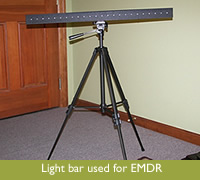EMDR Therapy ~Eye Movement Desensitization and Reprocessing
EMDR (Eye Movement Desensitization and Reprocessing)
If you are troubled by upsetting memories from the past, have experienced trauma, or find yourself repeating painful patterns and similar life issues over and over again, EMDR can help. EMDR effectively alleviates symptoms of distress while at the same time promotes shifts toward healthier reactions. With EMDR change is rapid and the length of time to experience the benefits of psychotherapy significantly shortened.
What is EMDR?
Trauma, disturbing memories, and negative self-beliefs get trapped in our nervous system, triggering unconscious reaction that causes us to perceive the present through past experiences. The resulting symptoms of these trapped disturbances can be excessive fear, hyperarousal, phobias, intrusive memories, and even overreaction to perceived slights from others. The set of symptoms can be as full blown at Post Traumatic Stress Disorder (PTSD), or at the very least what Carl Jung called our complexes. Many of us know complexes today as our emotional buttons. Left unresolved these complexes can get in the way of friendships, intimate relationships, work situations, career, and even our ability to experience happiness and inner peace. With EMDR, a science based approach using eye movements in the process of therapy, memories which continue to cause painful reactions are released from the nervous system and resolved.
How Does EMDR Work?
EMDR works because it follows the natural processing and healing functions of the mind, much in the same way our body heals from physical trauma. Rapid eye movement, such as in REM sleep, is the natural method our brain utilizes to process experiences and events. During rapid eye movement the right and left hemispheres of our brain are alternatively stimulated and memories activated and processed. This allows the memories to be released from the nervous system and consequently opens the potential for our mind to create new neural pathways for healthier responses. Clients receiving EMDR therapy report increasingly neutral emotional reactions to the memories and to current life events related to the memories. The results of EMDR are greater integration of healthy coping responses and an increased ability to live and make choices based on present circumstances.
8 Phases of EMDR Treatment
The EMDR approach has eight phases of treatment, beginning with the first three: history taking, treatment planning, and preparation.
During the preparation phase clients are taught stress reduction tools, relaxation and coping strategies and gain an understanding of how their experiences and beliefs are related to the current symptoms they experience. The time it takes for these initial phases is individual to each client’s needs. Speed is not the issue here as the greater the client’s insight and trust the more effective the following phases are.
 During the reprocessing phases specific memories related to present day difficulties are targeted along with corresponding emotions, beliefs and related body tension. The therapist leads eye movements either using a light bar or hand movements. A light bar is simply a horizontal bar with a soft blue light that moves back and forth. Alternatively, head phones or thumb pulsers can be attached to the light bar and used for bilateral tones or taps. During the eye movements the memories are stimulated and released, while a new positive self-belief is incorporated and enhanced. Any emotional disturbance the client may experience during this phase is released rapidly and permanently from the nervous system. The client remains in control of the pace and can stop or start as requested. In addition, clients remain in the comfort and security of the office setting with the support and coaching of a trained clinician. During the reprocessing phases specific memories related to present day difficulties are targeted along with corresponding emotions, beliefs and related body tension. The therapist leads eye movements either using a light bar or hand movements. A light bar is simply a horizontal bar with a soft blue light that moves back and forth. Alternatively, head phones or thumb pulsers can be attached to the light bar and used for bilateral tones or taps. During the eye movements the memories are stimulated and released, while a new positive self-belief is incorporated and enhanced. Any emotional disturbance the client may experience during this phase is released rapidly and permanently from the nervous system. The client remains in control of the pace and can stop or start as requested. In addition, clients remain in the comfort and security of the office setting with the support and coaching of a trained clinician.
The final phases involve closure, reevaluation, and preparing for future situations. EMDR is not complete until the client is able to perceive future related experiences with positive self-beliefs and positive emotions.
Who Can Benefit From EMDR?
EMDR works with clients of all ages for the following conditions:
• PTSD -
EMDR is an effective and rapid method for healing PTSD, as shown by extensive scientific research studies. Guidelines on PTSD from the National Institute for Clinical Excellence (NICE, 2005) includes EMDR as one of two trauma focused psychological treatments that should be offered to clients with PTSD. In addition, guidelines on PTSD from the American Psychiatric Association (APA, 2004) states that EMDR Has been shown to be “effective for core symptoms of acute and chronic PTSD.”
EMDR is highly effective in treating any symptoms related to past trauma or disturbing memories including, but not limited to:
• Anxiety
• Panic Attacks
• Phobias
• Trauma (sexual, physical, emotional)
• Depression
• Social Anxiety
• Childhood Abuse
• Self Esteem and Self Doubt
• Performance Anxiety
Debra Young MA, LMHC is an EMDR Institute trained clinician who has successfully treated a variety of concerns using EMDR therapy.
Additional resources:
• EMDR Institute: http://www.emdr.com
• Getting Past Your Past: Take Control of Your Life with Self-Help Techniques from EMDR Therapy, by Francine Shapiro, Ph.D
|